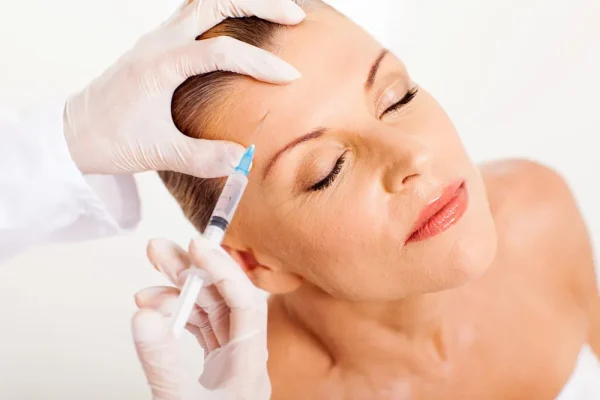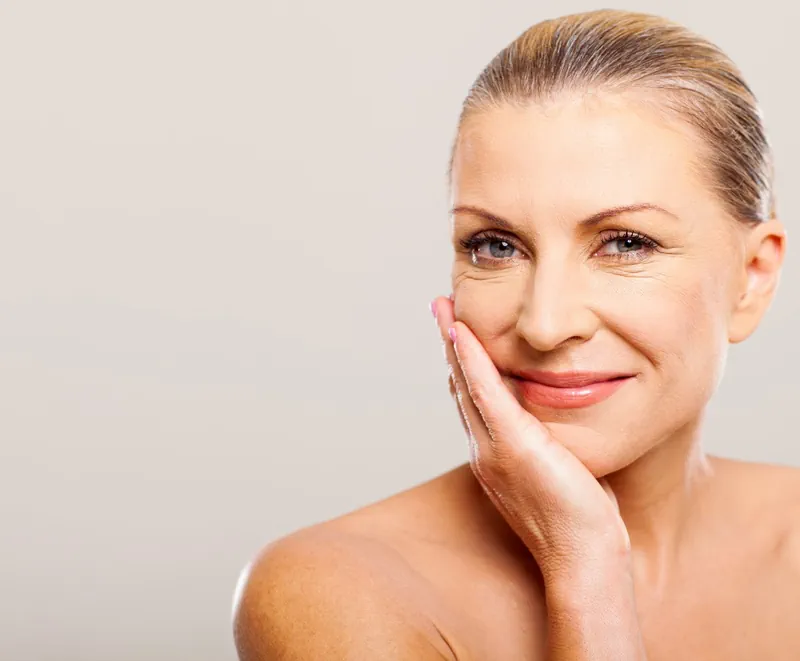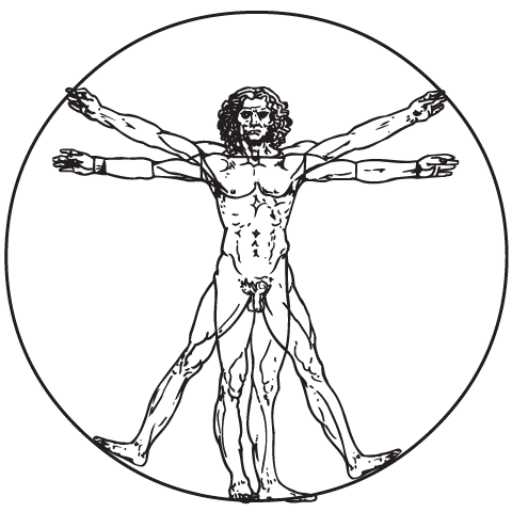Botox Treatment Vienna
In the field of aesthetic medicine, Dr Sylvia Orasche offers both in 1180 Viennaas well as in Tulln, Specialist Botox treatments on. She always takes care to achieve a natural result.

Table of contents
What is Botox?
Botox is the name for botulinum toxin. It is a neurotoxin (nerve poison) secreted by the bacterium Clostridium Botulinum.
Botox has been used to treat neurological diseases since 1980.
In aesthetic dermatology, the strong and long acting botulinum toxin A is used, but only in such a minimal dose that it does not trigger any reaction on the body.
Botox effect
The effect of Botox is based on inhibiting the release of the transmitter substance acetylcholine, which is responsible for the nerve impulses of the muscles. Through a Botox injection, the corresponding muscle tissue can no longer be tensed for a few months. Botox was approved for medical purposes in 2002 and is used today for the Smoothening of wrinklesbut also with excessive sweating or chronic migraine.
In order to achieve good results from Botox treatments, it is of great importance that they are carried out by doctors who have the anatomical expertise to do so and who are familiar with the correct individualised dosage and sterile administration of Botox.
Areas of application for Botox
Botox for the forehead
With a Botox treatment, small expression lines, such as frown lines between the eyes, can be smoothed out. No anaesthetic is required. Dr Orasche uses synthetically produced Botox of the highest quality in the laboratory. The powder is diluted in a saline solution and the individual dose is determined.
The area to be treated is first cooled and disinfected. Then a very thin needle is applied under the skin in the area of the corresponding small muscles. Botox paralyses their function so that wrinkles can no longer form temporarily.
Botox for the lips
Contrary to popular belief, Botox is not normally used for lip augmentation. It is possible in principle, but usually the filler hyaluronic acid is used to model the lips. Lips can be treated very well with Botox, but it can cause annoying wrinkles around the mouth.
Botox eyebrows:
With Botox, experienced dermatologists have the possibility to raise the eyebrows without surgery. In this process, the muscle pull of the forehead muscles is controlled by targeted injections of Botox. Normally, the effect of Botox can be seen after two weeks. The eyebrows lift by 1 to 3 cm and the eyelid wrinkles disappear. Alternatively, Dr. Orasche can perform a thread lift or combine Botox with hyaluronic acid for optimal results.
Botox for excessive sweating (hyperhidrosis)
Therapy with botulinum toxin A has proven to be an effective measure for excessive sweating. The nerve toxin inhibits the release of acetylcholine from the nerve cells, which normally stimulates the sweat glands to become active. This makes you sweat less. The effect lasts for about six months, after which new nerve cells have grown into the sweat glands - the treatment has to be repeated.
Botox for migraine:
With the Treatment of chronic migraine Botox is applied by the doctor in several places in the muscles of the head, neck and shoulder area. This relaxes the treated muscles. The use of Botox for migraines can prevent or alleviate further migraine attacks.

Frequently asked questions about Botox treatment
Where is Botox treatment used?
Botox is injected for the treatment of forehead wrinkles (frown lines), chin and eye wrinkles (crow's feet). There are also applications for hyperhidrosis (excessive sweating) and migraine. A specialist medical history is taken for each application.
When do you see the Botox treatment results?
The visible result of the Botox treatment sets in after two to three days, the full effect after about one week. The effect depends on the individual's ability to regenerate and lasts between three and six months.
How long does Botox last?
The duration of Botox wrinkle injections is limited and lasts about four to six months. If you are satisfied with the treatment, it can be repeated as often as you like to prolong the effect.
Are there any side effects with Botox?
All substances can, in extremely rare cases, cause the formation of so-called granulomas. These are small nodules that occur in the body, possibly as a reaction to foreign substances.
When Botox is used cosmetically, bruising (blue spots) or short-term headaches may occur. If too much is injected or if it is injected in the wrong places, facial expressions may be paralysed, resulting in a "mask-like face". The risk of side effects from local injections with Botox is reduced when performed by qualified specialists.
Dr. Orasche has many years of experience with this type of treatment and makes sure that the injections lead to a natural-looking result.
How many units of Botox are used?
For a treatment of mildly pronounced frown lines, about 20 Botox units are needed (four injections of five units each). The dosage for deep frown lines is between 30 and 40 Botox units.
Botox has a dangerous effect on the human body from 2500 units.
Who should not have Botox treatment?
Dr.Orasche conducts a detailed consultation at the beginning of the treatment.
They will be asked about any allergies and medication they are taking.
Patients with nerve or muscle diseases and coagulation disorders should not be treated with Botox.
What should I bear in mind with regard to medication and treatment with Botox?
Patients who are treated with anticoagulant medication may experience bruising or bleeding. The situation requires that you inform your attending doctor about this.
What does Botox treatment cost?
The costs vary depending on the treated area and doctor.
A treatment for forehead wrinkles costs on average between 250 and 350 euros.
If a combination treatment with drooping eyelids or crow's feet is carried out, one has to reckon with 350 to 500 Euros.
Exact details of the treatment costs can only be given after a personal presentation. We ask for your understanding.
Patient testimonials
- Die Mitarbeiterinnen von Dr Orasche sind sehr hilfsbereit, lustig und kompetent. Die Frau Doktor wurde heute vertreten, also kann ich zu ihr nicht viel sagen, aber ihre Vertretung war sehr lieb und verständnisvoll. Das ist meine erste Rezension bei einer Ärztin weil ich einfach absolut begeistert war. So ein tolles Team 👌Read morelessPIA D.31/07/2025Ich bin vor ca. 6 Jahren zufällig auf Frau Dr.Sylvia Orasche gekommen. Frau Dr. Orasche ist eine sehr kompetente, einfühlsame und verständnisvolle Ärztin, die sich sehr viel Zeit für die Probleme und Anliegen nimmt, um gemeinsam zu einer optimalen Lösung zu kommen. Ich persönlich kann nur meine beste Empfehlung für diese Ärztin weitergeben!Read morelessAndrea B.16/05/2025I am so glad that Dr Orasche was recommended to me! I have been suffering from abscesses in the same place for years and no other doctor took me seriously. Dr Orasche encouraged me to quickly start the treatment she recommended and she was right. I haven't had such beautiful skin for years. Thanks to Dr Orasche I have a completely new body and skin feeling. Thank you very much!Read morelessMiri B.14/04/2025
- Excellent and accurate doctor. Takes her patients seriously. Comes to the surgery in exceptional cases, even if late in the evening.Read morelessBirgit K.27/03/2025Dr Sylvia Orasche is friendly, sympathetic, empathetic and very competent; she takes a lot of time and explains everything in detail; I was treated there with a laser due to xanthelasma on my upper eyelid. Absolutely painless and scar-free. always happy to return!!!Read morelessOliver L.26/03/2025I am extremely grateful to Dr Sylvia Orasche and her team for the first-class treatment of my acne. I had been struggling with severe skin problems and abscesses for a long time, but thanks to her expert care, targeted drug therapy and laser treatment, my complexion improved considerably in a short time.Dr Orasche impresses not only with her high level of professionalism, but also with her friendliness and empathy. Her entire team also deserves great praise for their consistently warm and helpful care.Read morelessEnrique A.20/03/2025
- I have had chronic acne for decades and have tried several doctors. Dr Orasche is the first doctor who has been able to help me with a wide range of treatments. She looks at the person as a whole, which is very much neglected in this day and age. And I would also like to thank Dr Orasche's supportive team! Thank you very muchRead morelessroland z.06/03/2025Dr Orasche is a competent and very emphatic doctor. She takes enough time to answer all questions thoroughly. Her friendly and empathetic manner makes you feel at ease during your treatment. Her professional expertise and commitment make her an excellent doctor who I can definitely recommend.Read morelessMartina W.18/02/2025Over the last 20 years, I have been to many dermatologists/doctors/specialists because of my inflamed pustules and mainly because of abscesses with fistula formations in the intimate/groin/anal/buttocks area. From remote diagnoses with "That's just the way it is, you'll have to live with it" to "They're open and leaking anyway", everything was there. Most recently, I was at the outpatient clinic every three weeks to have abscesses opened in various regions. Despite financial constraints and in order not to lose my job, I took heart and went to see Dr Orasche. She knew what was wrong after just one look and started treatment straight away! She also recognised that my hormone balance was not right. After just 3 treatments with laser/ointment/tablets, both my skin and my state of mind have improved considerably. I am delighted with Dr Orasche and her team! 100%ige recommendation to all those seeking help!Read morelessDakota C.11/02/2025
- I have been in treatment with Dr Orasche since the beginning of 2024 and I can only say that she has not only helped my skin but also my self-confidence massively. When I started my treatment I had very severe acne which was not only physically but also psychologically a burden. My skin is now smoother than it has been since I was a child and I finally feel good again. Dr Orasche and her whole team are great, always have an open ear, you feel you are in good hands during every treatment and every question is answered.Read morelessANJA P.11/02/2025
Patient testimonials
- Die Mitarbeiterinnen von Dr Orasche sind sehr hilfsbereit, lustig und kompetent. Die Frau Doktor wurde heute vertreten, also kann ich zu ihr nicht viel sagen, aber ihre Vertretung war sehr lieb und verständnisvoll. Das ist meine erste Rezension bei einer Ärztin weil ich einfach absolut begeistert war. So ein tolles Team 👌Read morelessPIA D.31/07/2025Ich bin vor ca. 6 Jahren zufällig auf Frau Dr.Sylvia Orasche gekommen. Frau Dr. Orasche ist eine sehr kompetente, einfühlsame und verständnisvolle Ärztin, die sich sehr viel Zeit für die Probleme und Anliegen nimmt, um gemeinsam zu einer optimalen Lösung zu kommen. Ich persönlich kann nur meine beste Empfehlung für diese Ärztin weitergeben!Read morelessAndrea B.16/05/2025I am so glad that Dr Orasche was recommended to me! I have been suffering from abscesses in the same place for years and no other doctor took me seriously. Dr Orasche encouraged me to quickly start the treatment she recommended and she was right. I haven't had such beautiful skin for years. Thanks to Dr Orasche I have a completely new body and skin feeling. Thank you very much!Read morelessMiri B.14/04/2025
- Excellent and accurate doctor. Takes her patients seriously. Comes to the surgery in exceptional cases, even if late in the evening.Read morelessBirgit K.27/03/2025Dr Sylvia Orasche is friendly, sympathetic, empathetic and very competent; she takes a lot of time and explains everything in detail; I was treated there with a laser due to xanthelasma on my upper eyelid. Absolutely painless and scar-free. always happy to return!!!Read morelessOliver L.26/03/2025I am extremely grateful to Dr Sylvia Orasche and her team for the first-class treatment of my acne. I had been struggling with severe skin problems and abscesses for a long time, but thanks to her expert care, targeted drug therapy and laser treatment, my complexion improved considerably in a short time.Dr Orasche impresses not only with her high level of professionalism, but also with her friendliness and empathy. Her entire team also deserves great praise for their consistently warm and helpful care.Read morelessEnrique A.20/03/2025
- I have had chronic acne for decades and have tried several doctors. Dr Orasche is the first doctor who has been able to help me with a wide range of treatments. She looks at the person as a whole, which is very much neglected in this day and age. And I would also like to thank Dr Orasche's supportive team! Thank you very muchRead morelessroland z.06/03/2025Dr Orasche is a competent and very emphatic doctor. She takes enough time to answer all questions thoroughly. Her friendly and empathetic manner makes you feel at ease during your treatment. Her professional expertise and commitment make her an excellent doctor who I can definitely recommend.Read morelessMartina W.18/02/2025Over the last 20 years, I have been to many dermatologists/doctors/specialists because of my inflamed pustules and mainly because of abscesses with fistula formations in the intimate/groin/anal/buttocks area. From remote diagnoses with "That's just the way it is, you'll have to live with it" to "They're open and leaking anyway", everything was there. Most recently, I was at the outpatient clinic every three weeks to have abscesses opened in various regions. Despite financial constraints and in order not to lose my job, I took heart and went to see Dr Orasche. She knew what was wrong after just one look and started treatment straight away! She also recognised that my hormone balance was not right. After just 3 treatments with laser/ointment/tablets, both my skin and my state of mind have improved considerably. I am delighted with Dr Orasche and her team! 100%ige recommendation to all those seeking help!Read morelessDakota C.11/02/2025
- I have been in treatment with Dr Orasche since the beginning of 2024 and I can only say that she has not only helped my skin but also my self-confidence massively. When I started my treatment I had very severe acne which was not only physically but also psychologically a burden. My skin is now smoother than it has been since I was a child and I finally feel good again. Dr Orasche and her whole team are great, always have an open ear, you feel you are in good hands during every treatment and every question is answered.Read morelessANJA P.11/02/2025

